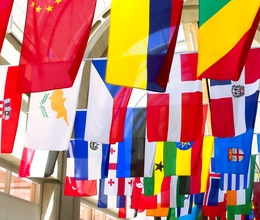
Leading Meetings with Multicultural Audiences
 The Problem
The Problem
With the increasing prevalence of virtual teams that span the globe, multicultural audiences are becoming more common. Meeting leaders must be poised to meet the unique needs of these groups. One of the key roles of any meeting facilitator is to create a safe environment where all participants feel valued and included. When the meeting includes participants representing a variety of different cultures and backgrounds, this can be somewhat challenging. Here are a few tips to keep in mind when leading a session with a multicultural audience.
Consider these Suggestions
- Conduct research to learn a bit about the cultures represented in the group. Kiss, Bow, or Shake Hands (by Morrison and Conaway) does a great job of explaining various cultural customs and relevant business etiquette.
- Make an effort to respect cultures represented. For example, avoid gestures or phrases that might be offensive in their culture (e.g. the ok sign made with the hand is an offensive gesture in certain cultures).
- Consider cultures when formulating questions. For example, for those cultures with a tendency toward always responding affirmatively to requests, ask “When can you complete this task?” instead of asking “Can you complete this task by Friday?”
- Select a meeting time that respects all time zones. If in doubt, solicit feedback from the group.
- Bring business cards to the meeting and be sure to accept business cards by holding them with both hands.
- Don’t be afraid to ask a speaker with an accent to repeat themselves slowly to ensure their point is heard by all. If necessary, repeat their point to the larger group to ensure it was fully comprehended. However, if you summarize their point, check back with them to ensure your summary is indeed accurate.
- Ensure that selected meeting dates don’t infringe on religious or other regional holidays.
- Be respectful of cultural preferences when making food selections – offer a variety of selections including vegetarian options and avoid red meat if possible.
- Try to touch base with non native language speakers prior to the meeting to personally introduce yourself and solicit their feedback on any adjustments that might make their participation easier.
- Select a language that is native to most participants, and consider using an interpreter if necessary.
- Avoid idiomatic expressions, jokes, or references that might not be understood by all.
- Plan additional time into the agenda to allow speakers the opportunity to speak slowly and clarify if needed.
- Plan time into the agenda to socialize informally before the meeting officially starts.
Don’t forget to leave your comments below
Dana Brownlee is President of Professionalism Matters, Inc. a boutique professional development corporate training firm. Her firm operates www.professionalismmatters.com and www.meetinggenie.com, an online resource for meeting facilitation tips, training, and instructional DVDs. Her latest publications are “Are You Running a Meeting or Drowning in Chaos?” and “5 Secrets to Virtually Cut Your Meeting Time in Half!” She can be reached at [email protected]